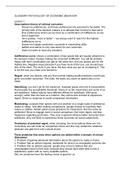GLOSSARY PSYCHOLOGY OF ECONOMIC BEHAVIOR
Lecture 1
Assumptions theory of rational consumer:
- Knows his preferences, and these preferences are assumed to be stable. The
primary task of the decision-makers is to allocate their income to best serve
their preferences which can be done by a combination of indifference curves
and a buget line.
- He is greedy, “more is better” – we always want to reach for the highest
indifference curve
- Knows his budget constraints, succeeds in maximizing utility
- Selfish and seems to only care about his own outcomes
- Does not seem to have any emotions
Indifference curve: shows a combination of two goods that are equally attractive to
the decision maker, thereby making the consumer indifferent. You will be similarly
happy with each combination you get on the same line, and you always aim for the
highest line. Negative slope because if you have more of the one, you should have
less of the other. The more X you have, the less value you put on increasing X. This
is not the way you make your decisions.
Regret: when you decide, and you find out that making another decision could have
given you better outcomes. The older, the lower you score on greed (why is not
clear).
Satisficing: you don’t go for the maximum, evaluate goods until one is encountered
that exceeds the acceptability threshold. Some of us are maximizers and some of us
are satisficers. Added options have different effects for satisficers. With good
enough, rather than the best as a criterion, they will be less inclined to experience
regret. Show no response to social comparison information.
Maximizing: compare their options with one another on a single scale of preference
(value or utility). And after making comparisons, people choose to maximize their
values or utilities. Added options pose problems for maximizers. Not the same as
perfection! Show to engage more in social comparison, feel more regret, and less
happiness regarding purchases. They may in general achieve better outcomes than
satisficers, they are likely to experience these outcomes as worse subjectively.
Avoidance of potential regret: when choosing, the more options there are, the
more likely one will make an nonoptimal choice and this may undermine whatever
pleasure one gets from one’s actual choice.
Three problems that arise when options are added within a domain of choice
(Schwartz):
1. Problem of gaining adequate information about the options to make a choice
2. Problem that as options expand, standards for what is an acceptable outcome rise
3. Problem that as options expand, people may come to believe that any
unacceptable result is their fault, because they should have been able to find a
satisfactory option with so many available options
Still, we somehow have the feeling choice is good for us.
, Ultimatum bargaining game: there is an allocator and a recipient. The allocator can
offer the recipient an amount of his money. The recipient can either accept this offer,
or reject it. If he rejects it, he gets nothing. Schwarz induced regret for higher offers
(before, allocators could only regret low offers), by providing people with feedback on
the minimal acceptable offer afterwards.
Satiation: I’ve had enough. Repeated choosing and reflecting on experience
(drawing attention to repetitiveness) increases satiation and decreases satisfaction.
It’s not about making choices, it’s about repetitiveness (Redden, Haws & Chen). An
increase of enjoyment can be obtained by limiting (repetitive) choice.
Greed: tendency to always want more and never be satisfied with what one has.
- Not the same as maximizing (making the best of something vs just wanting more)
- Not the same as self-interest (indifferent to others vs downgrading others)
- Not the same as envy (comparing with others vs comparing to imaginary situation)
- Not the same as materialism (greed does not only apply to material goods)
Greedy people are more impulsive, psychopath, feel more entitled, less empathy,
less self-esteem and life satisfaction, more social comparison, lower
conscientiousness and openness.
Axiom of greed: if A contains more of one good than B, and at least as much as B of
all other goods, A will be preferred over B.
Dictator game: same as ultimatum game, however, recipient does not have the
ability to reject the offer. The more greedy, the more people allocated money to
themselves and make unfair offers (greedy people also do this in the ultimatum
game).
Lecture 2
Prospect theory (Kahneman & Tversky): people do not evaluate possible
concequences according to their outcomes, but according to their expectation of the
subjective value of the decision. They use Bernouilli’s (we are always risk aversed)
proposal in the gain frame. Subjective value lowers when you have more, making
people risk aversed when gaining (concave shape). They put losses in the graph too,
they expanded the graph into the negative domain – the more we lose the more we
feel bad, but this graph flattens (same as in the positive domain, however convex,
making us risk seeking).
3 main characteristics of Prospect Theory:
1. There is a reference point (the status quo, determine if you get better or worse
from it)
2. Risk averse and risk-seeking behavior (cause = shape of the curves, concave (hol)
vs convex (bol)) THE SHAPE IS WHAT PREDICTS RISK AVERSE OR RISK
SEEKING.




